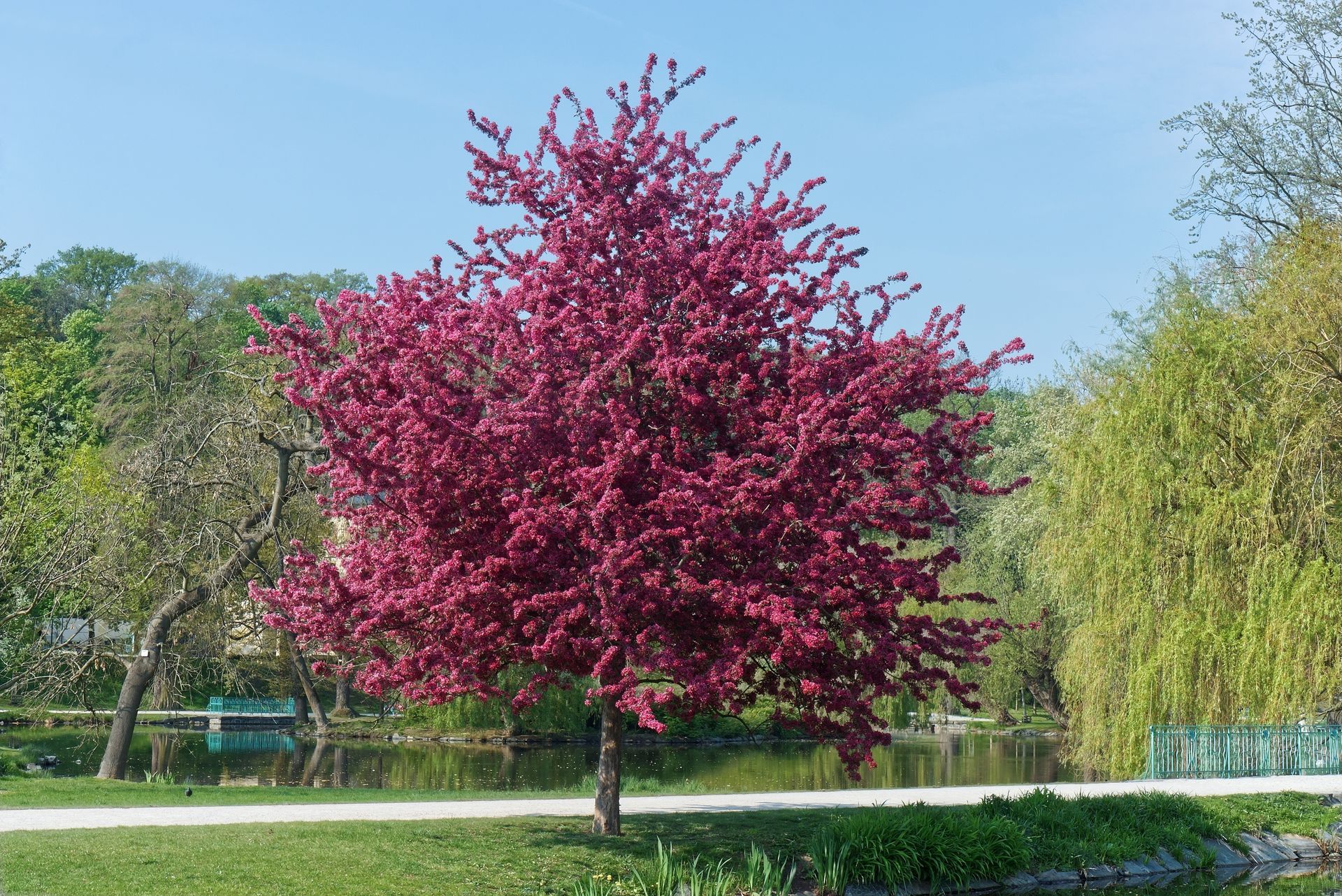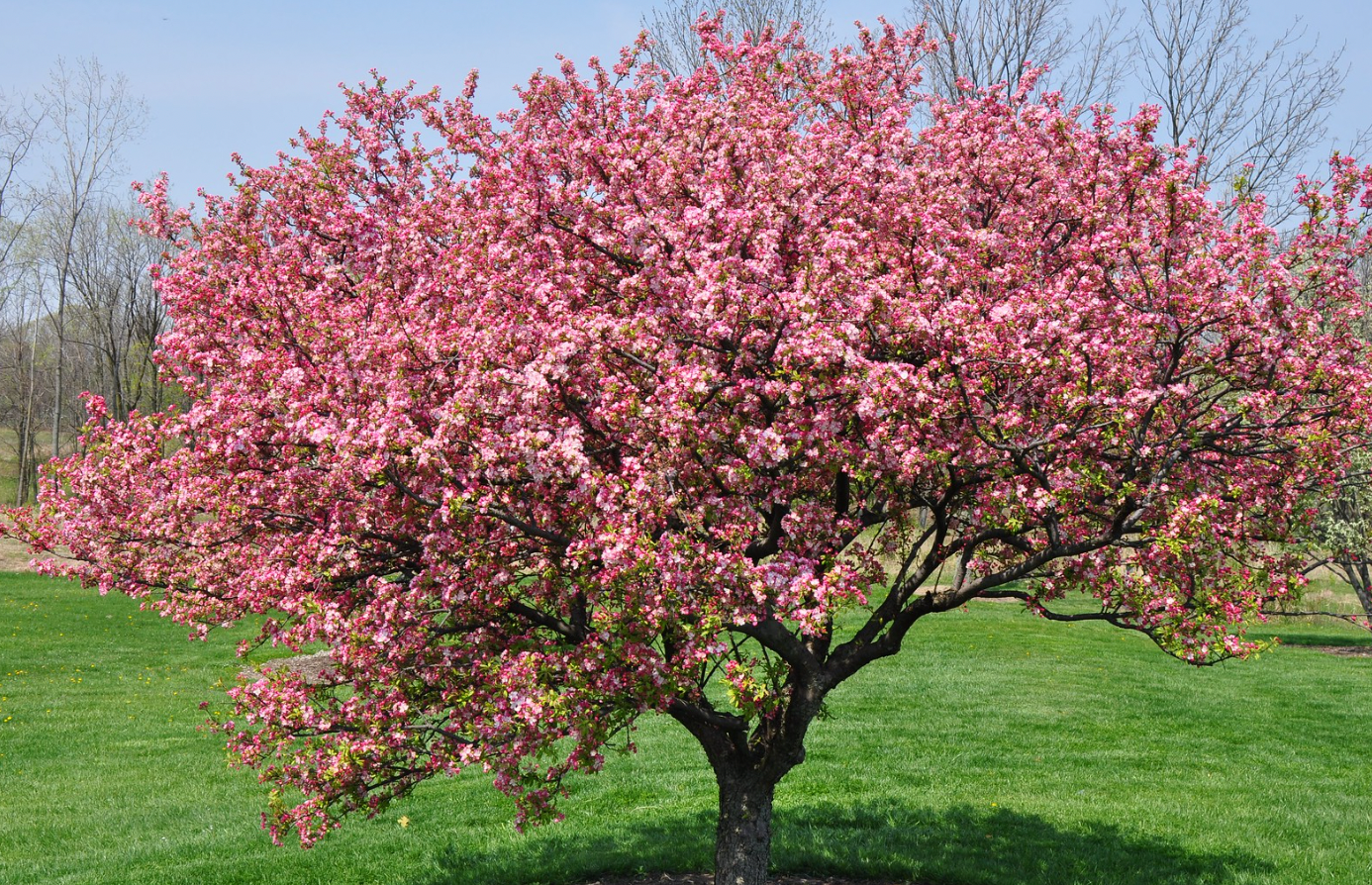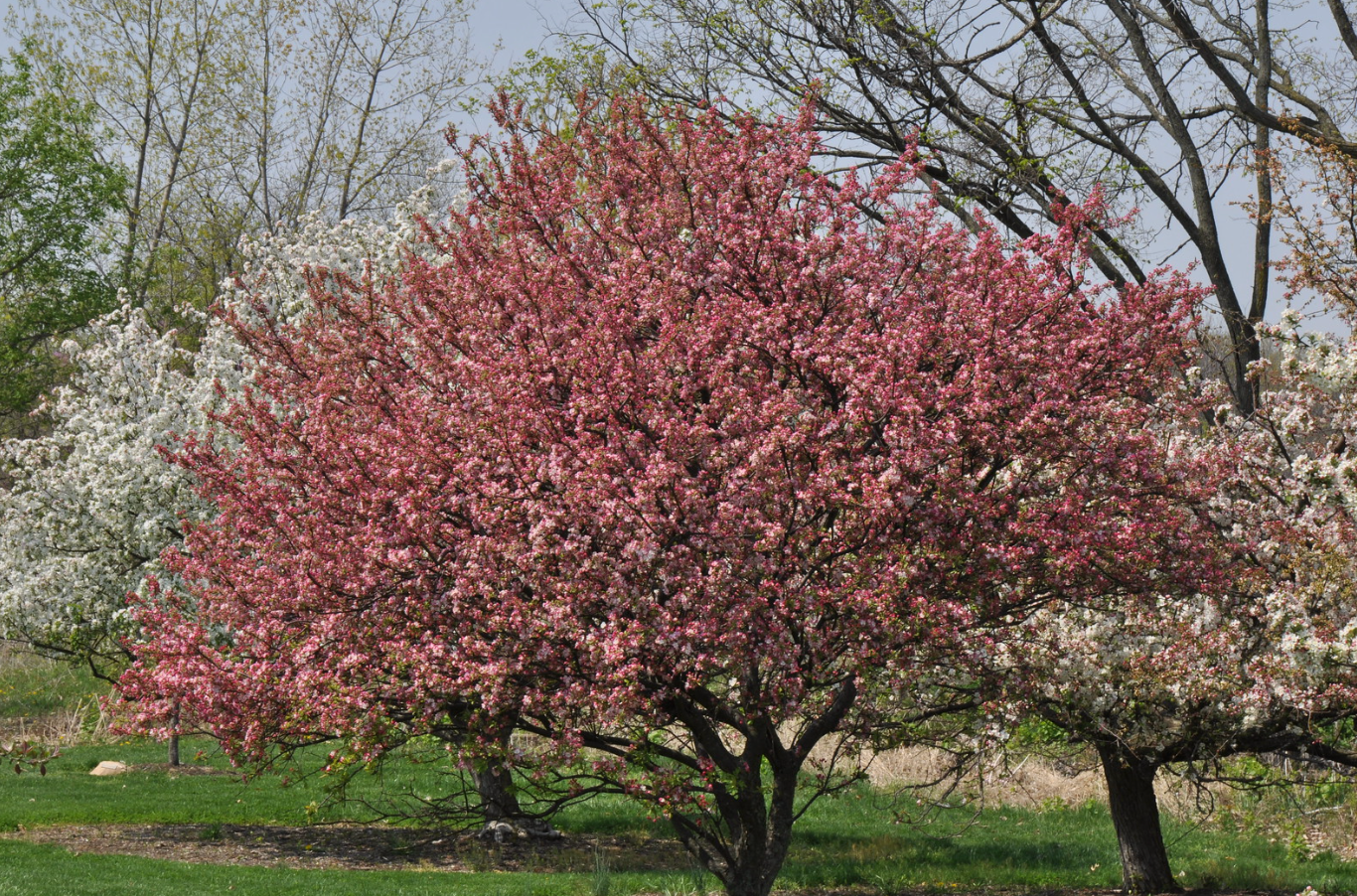Flowering Crabapple Tree Care

Flowering crabapple tree care isn't exactly hard as long as you know the basics. Our guide covers all the necessary information below.
Fast Facts for Flowering Crab Apple Trees
| Common Name | Apple, Crabapple, European Crab Apple |
|---|---|
| Scientific Name | Malus domestica |
| Month(s) of Harvest | October to November |
| Light | Full sun, 6 hours per day |
| Water | Regular watering in the first year of growth |
| Soil | Well-drained soil rich in organic matter |
| Fertilizer | 1 to 2 pounds of fertilizer per 9.29 square meters or 100 square feet |
| Pests | Codling moth, red spider mite, aphids, scale insects, and juniper-apple rust |
| Diseases | Cedar-hawthorn rust, scab, cedar-apple rust, and fire blight |
| Growing Zone | 4 to 8 |
Table of Contents

Credit: Ted
Flowering Crabapple Tree Care
Flowering crabapple trees are one of the best front yard trees. When flowering crabapple trees, you should know about their soil requirements, root inspection frequency, placement, and sunlight needs. Here's a detailed guide on flowering crabapple tree care.
Soil & Container
A crabapple flowering tree requires soil with good drainage. The soil should also be rich in organic matter. Since crabapples prefer slightly acidic soil, ensure the soil's pH is acidic, ranging from 5.5-6.5. If the soil is not of the right pH, you can add either organic matter or fertilizer to adjust it.
You might also have to add other soil amendments, such as compost or mulch, to the soil for better drainage.
In case you're planting a flowering crabapple tree in a container, use a potting mix that has a combination of soil, sand, and compost. The container should have a volume of at least five gallons.
Do not put the crabapple tree-containing pot close to another plant with dense foliage. It might block the sunlight coming to the crabapple plant. Since crabapple trees need ample direct sunlight daily, the shady conditions might stunt their growth.
Root Inspection
When you transplant the crabapple flowering tree, inspect its roots. If the root system is overgrown, cut off about one-third of the roots to ensure the tree can absorb adequate water and nutrients.
Also, make sure the roots are not circling or intertwined. If they are, loosen them up with your hands.
As a rule of thumb, the root ball's soil must be an inch lower than your pot's top level so that you can add the remaining soil.
Water Requirements
As the table above mentions, crabapple trees need regular watering during their first growth year. Whether through irrigation or overhead watering, you need to get new trees enough water to get them established. But once apple trees are established, you do not need to water them excessively unless the season is exceptionally dry.
Crabapple trees are generally drought-resistant. But if your area hardly gets any rain, you can deep water your tree at the base once a week in the morning. An inch of water per week should be enough in combination with irrigation and rainfall.
On the contrary, if your area gets too much rainfall, it might affect your tree's productivity and growth cycle. You can keep your crabapple trees safe from water damage by installing barriers or tarp over the tree's roots.
Fertilizing and Filling
Flowering crabapple trees do not need too much fertilizer. You can put some compost around the roots of your tree in spring. Combine it with a light supply of composted manure late in the fall months.
Alternatively, you can use natural mulch, such as pine bark and wood chips, to keep the soil's nutrient levels high.
Sun & Placement
Crabapple trees thrive under direct sunlight but aren't too fond of hot weather. Instead, they like temperate climates with cold winters.
Place your crabapple tree away from nearby buildings and tall trees that might block some sunlight. It should get at least six hours of daily sunlight.
Temperature and Humidity
Crabapple trees thrive most in regions with temperate summers and climates in the 4 to 8 USDA zone. Some varieties may grow in USDA 3 cold zone, while others can also survive the USDA 9 zone. But most of them require a temperature of 45 degrees Fahrenheit or below in winter.
Humidity should be below 60%. High humidity and high temperatures can result in bacterial and fungal diseases, especially with long-term exposure.
Pruning
The best time to prune crabapples is during the tree's dormant period. That's early spring or late winter. However, you can prune suckers at any time of the year. These small, fast-growing shoots come out of the ground at the base of the tree. Here's how to prune during the pruning season:
- Tackle the Base First: Prune sprouts and suckers at the tree's base. Otherwise, they may grow into new trunks, changing the shape of your tree.
- Prune Water Sprouts: These are small branches growing upright from larger ones. Cut them back to the next lateral branch. You can use pruners for this. But a folding saw may be needed if a branch is too large.
- Prune Diseased/Damaged Branches: When pruning diseased or damaged branches, cut as close to the trunk as possible. Cover the pruning cuts with a healing sealant to prevent bacteria and fungi entry.
- Remove Weak Branches:
Remove any crossing, rubbing, or weak branches that could snap and cause damage in storms.

Credit: Ted
Flowering Crabapple Tree Problems
Flowering crabapples are susceptible to certain problems and diseases. So, you should be prepared for them.
Not Flowering
There can be many reasons your crabapple tree isn't flowering. Here are some of them.
- Maturity: You might think it's about time you start seeing crabapple blossoms. But your tree may not be mature enough. Usually, it takes five to eight years for the crabapple tree to flower.
- Weather: If the season is drier than usual, your crabapple tree may not produce as many flowers in the spring. Likewise, the tree would not have gotten its required chilling period if winter had been warmer than usual. So, it may not bloom when spring arrives.
- Lack of Pruning: All spring flowering trees require pruning to ensure healthy and plentiful blooms. If you haven't been pruning your crabapple tree regularly, the branches may be competing for resources. That could result in less growth. Do not cut off the previous year's growth when pruning, as you'll lose flower buds that will bloom the following season.
Yellowing Leaves
Brown or yellow leaves are a notable symptom of apple scab. It is a fungal disease caused by excessive moisture and humidity. The fungus will infect the leaves, causing them to discolor and become distorted. Some other symptoms of apple scab include:
- Raised lesions on leaves, twigs, and fruit
- Green or black spots on the underside of leaves
You can avoid this problem by growing scab-resistant crabapple varieties. Here are some other measures:
- Do not plant crabapple trees in areas that get high spring rainfall.
- Use training systems and dwarfing rootstocks to maintain an open tree canopy.
- Do not use overhead irrigation as it can facilitate the apple scab infection period.
- Use sanitation practices to prevent carryover to nearby apple blossoms.
Protectant sprays should be applied at the beginning of the growing season to prevent apple scab. Some post-infection sprays are also available, but they cannot cure the disease once the lesions are visible.
Wilting Leaves
Apple trees may have wilting leaves due to several reasons. Some include:
- Pests: Insects like aphids and spider mites can suck the sap from leaves, causing them to wilt. Treatment involves spraying insecticides or applying a suitable natural remedy.
- Drought: Water stress can cause leaves to curl and wilt. You can address this by watering the tree regularly. Drought conditions also make crabapple trees susceptible to Botryosphaeria canker, which can cause wilting leaves and branch dieback.
Damaged Leaves
A common cause of damaged crabapple leaves is cedar apple rust. The condition shows itself through the appearance of yellow spots on the leaves. These spots then turn bright orange-red and have a red border.
Over time, small black dots appear on the center of the leaf. Small fungal tubes also stick out below these leaf spots on the leaves undersides.
Hawthorn rust can also damage leaves through fungal projections. If the infection is too severe, leaves will turn yellow and fall.
Powdery mildew of flowering crabapple trees, caused by Podosphaera leucotricha, also affects leaves. The fungal disease shows as white patches on the upper part of the leaf, which may merge and cause the entire leaf to turn yellow and finally drop off.
The fungus also affects twigs, with white and grayish powdery spots covering them.
Learning About Flowering Crabapple Trees
There's a wide variety of crabapple cultivars. They can vary from each other in fruit production, hardiness, form size, bloom color, etc. Most modern cultivars have been made to resist common crabapple diseases, such as scab and fire blight. Here are some popular cultivars.
- Red Splendor: These crabapples have a dense and spreading form. Their blooms are deep pink flowers with yellow leaves in the fall. They have cherry-like fruit. The cultivar is known for its disease resistance and cold hardiness.
- Prairifire: With dark pink flowers and an upright habit, this cultivar has red-brown leaves and can grow up to 20 feet tall.
- Adams: These are standard-sized crabapple trees with a rounded shape. Their flowers are also deep pink, and the fruit is small and red.
- Beverly: With yellow foliage and glossy red fruit, the Beverly crabapple tree is resistant to apple scab. It also forms pure white blossoms and has a dense form.
- Callaway: The crabapple variety grows best in southern climates and is resistant to powdery mildew, crabapple rust, fire blight, and scab.
- Adironkak: Growing to 18 feet, the tree has orange-red fruits and white flowers. Its columnar shape is ideal for growing in narrow spaces.
When choosing a crabapple variety, you should ensure it has a persistent fruit, disease resistance, and a small to medium size. Additionally, you should make sure the tree is cold-hardy in your area.
The beautiful flower colors of a pink crabapple tree make it perfect for ornamental purposes before the tree starts fruiting. Once it is mature enough, the fruit will further add to its attractiveness.
Flowering Crabapple Origin Story
Crabapple trees originated in Kazakhstan, where they have been cultivated since ancient times. They now grow widely throughout North America, Europe, and South America.
It's believed that colonists brought crabapple seeds from Asia to Europe and North America from 1623 onward. Initially, the American crabapple orchards were used for hard cider. Growers added alcohol and fermented the apples to sterilize the cider.
No one really knows how the name 'crab' apple became popular. But the crabbed growth of the twigs is likely the reason behind this.
Did You Know? Crabapple was a symbol of death in folklore traditions. In the Baroque period, it was often used in paintings to depict the goddess of the soul, named Psyche. If a crabapple tree produces blossoms in autumn, people believe it to be a sign of imminent death in the family!
Sweet New Earth's Final Word On Flowering Crabapple Trees
The flowering crabapple tree care from this guide should help you plant healthy trees with ample fruit. Ideally, you should choose cultivars with significant disease resistance and weather tolerance. If you don't like the aesthetic of flowering crabapple trees, then maybe you are interested in Meyer lemon trees.
After you've planted flowering trees, prune water sprouts, damaged branches, and other limbs that might restrict the plant's supply of sunlight. The flower colors will depend on the cultivar.
Keep informed about prevention and treatment tips for common crabapple pest infections and diseases. Do not delay treatment, as most fungi spread quickly to neighboring trees, damaging your whole orchard.
Also, rake the ground beneath your crabapple tree clean of fruit debris and leaves before winter. It will prevent overwintering of insect larvae and fungi. Finally, add a layer of decomposed manure in late fall to enrich the soil with essential nutrients for the upcoming spring.

Christina Hernandez
Christina has done most of her research on environmental science but recently has changed her focus towards sustainable forestry. She has a passion for the outdoors and wants to spread that passion to the world.
Join our community!
Join to receive guides, insights, and the latest gardening deals!
